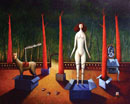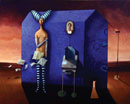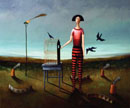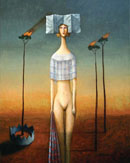In the work of Chilean artist Edwin Rojas, we clearly see what magical realism meant to Hispanic America: a zone where the artist sloughs off the imposition of the logical-rationalist thinking and gives free rein to his or her own inventiveness with imagination as the only guideline or gauge. An imagination propped up by that constant feature provided by the exhaustive mastery of the artistic values: line, composition, wealth of shades and tones interrelated with surfaces and highlighted by textures.
It’s the recovery of the liking for painting, from the ludicrous and the frolicking, while images and colors fit into a kind of fiction that recalls daily situations going on in the city and that comes up with a personal interpretation of the whole. The artist reinvents and creates a different story. That explains the existence of characters and settings marked by a dreamy atmosphere that deals with things far beyond belief and stunning only to become motifs of artistic preoccupation. A tribute to recurrent symbols of today’s painting is paid: hearts, hands, aircraft, cards and burning trees that rise to the sky like torches that speak about threats to the environment, to the surrounding setting in which characters develop, to nature itself and the silent woodlands of larches and firs that are still felled in southern Chile.
Scenes within scenes. An amusing theater based on the hilariousness frames inside the frames. Discontinuous panels that engulf the characters and sprawl toward the horizon of the local Chilean geography in which the lack of straight lines is the constant feature of a land inherited from the telluric forces that gave rise to the fantastic landscape that Rojas manages to splay on canvas
The piece entitled “Fortune in the Tub” recollects what we might consider the constants of Edwin Rojas’ painting: the surprise in terms of character layout and its lengthening. This provides this painting –and other like it- a common denominator of peculiarity imposed by the School of Paris by the hand of that whacko genius who ran by the name of Amadeo Modigliani. This tragic-life painter created a style of his own with an array of long necks and subtly elegant limbs that flex into a perfect steady balance. This is also seen in a recurrent fashion in the female iconography of evidently beautiful, somewhat mysterious white faces that light up his paintings, always steering from the center and splayed on a backdrop that appears in depth, relying on an thorough pictorial treatment of both the figure itself and the immediate environment, either of a house –as in this piece- or on the landscape that harbors successive planes and lights all the way to a sky pictorially degraded in rich shades of a same hue. The ocher-colored tones of “Fortune in the Tub” and the fancy blues of “Three Trees and a Queen” and “Bird Merchant” create an uneasy mystery very close to the one portrayed by Giorgio de Chirico.
Now, back to “Fortune in the Tub”, we might add that a stopped glimpse is seduced by the lighthearted use of the space in which the aerial perspective serves as a truce to portray an imagination alien to all conventions when it comes to representing perspective exit points. That explains the turns of a table seen in many artworks, many times featuring a passing car –the token of journeys construed as the addition of experiences- crowned with an antenna that drives on unnoticeably from one painting to the next. That’s also a symbol used by Antonio Segui who, like Rojas, kicks off experience-packed trips all across Hispanic America.
“The Best Menu Card” presents the painter disguised as a chef: the ingredients are his palette and the colors and flavors that he displays in this very painting in which the spectator is the guest of honor to a banquet that consists of tasting each and every detail of a plentiful and masterful painting, featuring a fine shade richness and subtle variations, just like a gourmet invitation. On a white table –a color that embraces a challenge in itself– Rojas takes pains in taming that hue to light up the scene. It’s no doubt homage paid to colorfulness, something that leads to the quotation to Claude Monet’s piece “Rising Sun Impression,” a key to understanding the liberation of the painting that makes light the star of the motley show, a light that right here is also worked on with complete freedom. Up to par with it, the artwork contains an evocative flair of yesteryear through the drapes commonly seen in academic painting.
In the “Bird Merchant” just another constant feature is appreciated, which is –alongside the thorough composition– the way of underlining contact zones marked off and built by the lines between the figure and the background, lines that make a clean cut off the color boundaries. If we add the formal stylization that’s not only seen in the main character, but also in all of the elements that make up the piece, the end result is the elevation feeling of flying birds. Just another addition is the circus ambience given by the fences and the dreamlike arrangement of the birds.
There’s no doubt that this is a painter of a kind, one of those who have strengthened their painting skills in recent years. Surprising pieces that speak volumes –on a second look– of that new glance that reveals what was once thought to be seen in the past.





Previous publication VISIBLE AND INVISIBLE, A CLEARING IN THE WOODS
Next publication Cildo Meireles. Against hegemonic ideas in art
Related Publications

How Harumi Yamaguchi invented the modern woman in Japan
March 16, 2022












